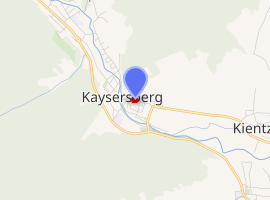Église Sainte-Croix, Kaysersberg
The Église de l′Invention de la Sainte-Croix (″Church of the Discovery of the Holy Cross″) or, colloquially, Église Sainte-Croix (″Holy Cross Church″) is the mostly medieval parish church of the small commune of Kaysersberg-Vignoble, in the Haut-Rhin department of France. The church is situated on the Romanesque Road of Alsace thanks to its ornate sandstone portal from ca. 1230–1235;[1] it is classified as a Monument historique by the French Ministry of Culture since 1932.[2]
| Église Sainte-Croix | |
|---|---|
| Église de l′Invention de la Sainte-Croix | |
.jpg) | |

| |
| Location | Kaysersberg |
| Country | France |
| Denomination | Catholic |
| History | |
| Founded | 13th century |
| Dedication | True Cross |
| Architecture | |
| Heritage designation | Monument historique |
| Designated | 11 May 1932 |
| Style | Romanesque Gothic Historicism |
| Completed | 19th century |
| Specifications | |
| Length | 29 m (95 ft) (inside) |
| Height | 12.35 m (40.5 ft) (inside) |
| Number of spires | 1 |
| Spire height | 41 m (135 ft) |
| Materials | sandstone |
| Administration | |
| Parish | Communauté de paroisses « Au pied du Galtz » |
| Archdiocese | Archdiocese of Strasbourg |
The Holy Cross Church was built in the first half of the 13th-century, then expanded and modified in the 15th-century, and finally partially modified again in the first half of the 19th-century, when the steeple was crowned with its characteristic dome.[3][4]
The church is filled with notable artworks, all of which are classified as Monuments historiques. Chief among them are the large wooden polychrome altarpiece of the Passion of Jesus, a 1518 work by the Colmar master Hans Bongart,[5][6] with painted 1621 wings by an otherwise unknown Mathias Wuest;[7] a large triumphal cross — height 425 cm (167 in) — from the late 15th-century;[8] a 1521 limewood relief of the Lamentation of Christ;[9] a 1514 sandstone Entombment of Christ;[10] a 1720 pipe organ;[11] besides a substantial number of statues, altars, crucifixes, liturgical objects, and other items ranging from the 15th to the 19th century.[12]
Gallery
.jpg) Romanesque main portal (1230s)
Romanesque main portal (1230s)- Altarpiece of the Passion (1518)
- Triumphal cross (1470s or 1480s)
- Lamentation of Christ (1521)
- Entombment of Christ (1514)
.jpg) Pipe organ (1720)
Pipe organ (1720)
References
- "KAYSERSBERG: Église Sainte-Croix". La Route Romane d'Alsace. Retrieved 23 September 2019.
- "Eglise catholique de l'Invention de la Sainte-Croix". culture.gouv.fr. Ministère de la Culture. Retrieved 23 September 2019.
- "L'église Sainte-Croix Trésor pour les yeux et pour l'esprit". location-kaysersberg.fr. Retrieved 25 September 2019.
- "Église paroissiale Sainte-Marie puis de l'Invention-de-la-Sainte-Croix". pop.culture.gouv.fr. Ministère de la Culture. Retrieved 25 September 2019.
- Baxandall, Michael (1980). The Limewood Sculptors of Renaissance Germany. New Haven and London: Yale University Press.
- "Retable de la Passion". 2.culture.gouv.fr. Ministère de la Culture. Retrieved 26 September 2019.
- "Peintures : Invention de la Vraie Croix et Annonciation". 2.culture.gouv.fr. Ministère de la Culture. Retrieved 26 September 2019.
- "Poutre de gloire". 2.culture.gouv.fr. Ministère de la Culture. Retrieved 26 September 2019.
- "relief : la lamentation". 2.culture.gouv.fr. Ministère de la Culture. Retrieved 26 September 2019.
- "Saint-sépulcre". 2.culture.gouv.fr. Ministère de la Culture. Retrieved 26 September 2019.
- "Kaysersberg, Ste Croix Joseph WALTRIN, 1720". À la découverte de l'Orgue Orgues d'Alsace. Retrieved 26 September 2019.
- "Mobilier". 2.culture.gouv.fr. Ministère de la Culture. Retrieved 26 September 2019.
External links
| Wikimedia Commons has media related to Église Sainte-Croix de Kaysersberg. |